Japanese Knives - Hocho
Content
Expert knowledge - Japanese Knives - Hocho
Japan has cultivated the aesthetics of food preparation like no other country, with the Hocho - the handforged knife - being the most important tool. With it, the cook celebrates the art of cutting, which makes the preparation of fine fish and delicate vegetables a feast for the eyes. The razorsharp cut doesn't crush the cells, the juice is retained, and the natural flavour of the foods comes into its own.
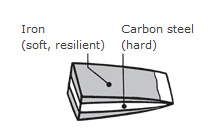
The blades are forged traditionally in multiple layers, with hard carbon steel forgewelded with tough iron. Only this elaborate procedure ensures an optimum synthesis of breaking strength and ultimate sharpness. In this respect, Hocho clearly show their relation to the Samurai sword.
The shape of these knives has developed solely from their intended purpose, which gives them an aesthetic quality not remotely influenced by fashion trends. The light wooden handles, the well-balanced design and the extraordinary sharpness make using Hocho a remarkable experience.
More than 25 years' import experience, the best contacts to leading Japanese forges and, last but not least, a 3-year warranty are your guarantee of quality for the blades.
- Ultra-sharp cutting for exquisite taste
The superb taste is achieved by a sharp, clean cut that severs the cells rather than squashing or crushing them, as a duller blade might. This also means that the food retains all its flavours. When cutting onions, a sharp blade has the added benefit that only a little juice leaks from the cuts - and it's mainly the essential oils contained in the juice that bring tears to the eyes.
- Minimal cutting effort
- They stay sharp longer and are very easy to sharpen
- The blade shapes are wide, the rear cutting edge stays sharp.
You can use the full length of the cutting edge, which is an advantage both for chopping and filleting.
- Santoku

All-round knife for meat, fish and vegetables (Santoku = the three virtues). Wide blade for good guidance along the finger knuckles.
- Gyuto

Versatile cooking knife for cutting up, filleting and preparing meat and fish. Slim blades for intricate tasks, pull or push cuts.
- Usuba

Vegetable knife with straight blade for clean cutting on the chopping board; paper-thin slices are no problem, even with ripe tomatoes. Wide blade for good guidance along the finger knuckles.
- Ajikiri

For small fish and for cleaning vegetables and salads, as well as chopping herbs.
- Sashimi

For cutting and filleting fish or ham with a pull stroke. Slim blade in the shape of a willow leaf or Katana (sword).
- Deba

For cutting fish and light mincing. Thick, wide blade. The back of the blade can be used to chop thin bones.
- Petty

Small all-purpose knife for fruit, peeling and cutting small objects.
As a start, we recommend a Santoku (all-purpose knife) and a Petty (fruit and peeling knife).
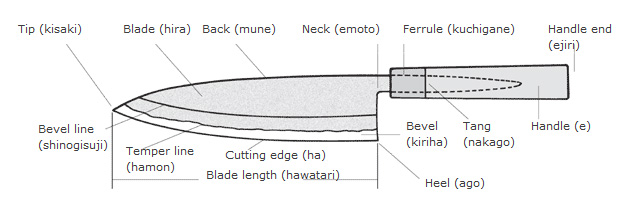
Highest quality: not rustproof
The Japanese company Hitachi Metals makes special cutting steels which represent the highest global standard and are used for almost all the Hocho we offer. These Yasuki Special Steels (YSS), named after their place of origin, are produced from iron sand, the same material that was used to make the legendary Samurai swords. They have a highly pure structure and thus offer the best achievable sharpness for cutting.
Different variants of this steel are used for different purposes:
- White Paper Steel (Unalloyed carbon steel)
is particularly hard and has an especially fine martensitic structure. This means you can grind it to exceptional sharpness, which it retains for a long time. These blades are particularly suitable for the gentle preparation of foods - but they are prone to oxidation, which means rust.
- Blue Paper Steel
A compromise is the slightly alloyed, corrosion-resistant Blue Paper Steel. Original Japanese knives made from these materials are treated with non-corrosive, food-safe oils (e.g. camellia oil) to prevent oxidation.
- PM steels
Nowadays, Western-style knives are also made from powder-metallurgy steels (socalled PM steels), which are even harder than low-alloy steel types and are even rustproof. However, they cannot be ground to such a fine cutting edge as unalloyed carbon steel (White Paper Steel). For more information on cutting steels, see »Expert Knowledge« on our website.
Forging by hand carefully forms the workpiece, always keeping it within the optimum temperature range. The striking force and frequency are applied as required. This results in a forming process that also benefits the crystalline structure of the metal, making it finer, which improves the mechanical and chemical properties of the steel. Forged blades can be distinguished in particular by the increasing thickness of the back of the blade towards the tang, which makes the blade stronger and improves the balance. The backs of stamped blades, on the other hand, are evenly thick.
In machine forging, only a few shaping steps are normally carried out, which calls for much higher temperatures than hand forging - and high heat has a negative effect on the structure.
Choosing the right knife depends primarily on the intended purpose (vegetables, fish, meat, all-purpose, etc.), but you should also consider how much time you are prepared to spend on looking after it. How »easy-care« a knife is depends mainly on the blade steel and the design of the handles:
Blade steel- Classic carbon steel (one or more layers): not rustproof. The blade must therefore be dried after use and regularly oiled. However, it achieves ultimate sharpness and is easy to sharpen.
- Carbon steel for the cutting edge, embedded in stainless steel (three or more layers). The blade is largely rustproof, only the exposed cutting edge can oxidise. A good compromise between maintenance requirements and ease of sharpening. As sharp as a).
- Stainless steel (one or more layers). The blade is rustproof and does not need to be oiled. However, due to the high chromium content, it is not as easy to sharpen (chromium affects the sharpening stone and causes a larger burr). These knives are also unfit for the dishwasher.
- Classic design with attached wooden handles: These can expand when wet and may become loose (light tapping will tighten them again). These knives must be kept dry.
- Design with full-length tang and handle shells (integral or semi-integral design): Depending on the material, these knives are normally hard-wearing. However, their centre of gravity is slightly further back and they are usually more heavy than a).
Widely used Japanese-looking knives from Asian low-wage countries are often only similar in shape to the original Hocho.
All Hocho offered by DICTUM come from Japan and are of the best quality.
You can distinguish mass-produced knives by the low quality of their materials and workmanship.
How do I recognise a Japanese knife?The visible quality features of original Japanese knives include:
- The traditional form.
- They often have a Japanese signature, not a Chinese one, which is usually engraved in the metal individually by the smith.
- As Japanese blades are always made of at least two and usually even three layers of metal, a wavy border line must be visible at the cutting edge.
- The so-called Suminagashi pattern - the damask-like structure of the multi-layer steel - is often imitated in cheap knives by etching, which becomes apparent at the latest during sharpening. When buying a knife, compare two knives of the same type. The etched pattern is always the same, while the structure lines of multilayer steel are slightly different in each knife.
- Original Japanese knives are all products of high-quality workmanship: The blade must be absolutely straight and must sit equally straight in the handle. No traces of machine grinding must be visible on the cutting edge, and the tip is also finely ground.
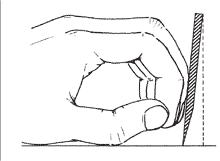
For precise cuts, e.g. for thin slices, guide the blade along the finger knuckles of the free hand.
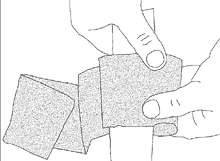
For peeling cuts, e.g. when cutting up a radish or cucumber, hold and turn the piece of food close to the cutting edge.
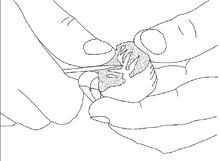
For decorative cuts, hold the blade close to the tip.
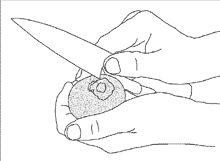
Use the back cutting edge for removing blemishes from fruit and vegetables, turning the piece of food.
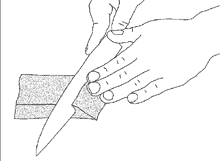
For filleting and sashimi, guide the knife with pulling strokes. The bevelled section points downwards.
The correct cutting pad - and this applies to all knives, not just original Japanese ones - is made of wood or plastic. Working on porcelain, marble or glass quickly dulls the blade. Unlike in European practice, Japanese chefs prefer soft woods such as gingko or cypress.
SharpeningContrary to some advertising claims, even the best knife will not stay sharp forever. Sharpening once in a while is therefore essential if you want to enjoy using your Hocho permanently. Japanese kitchen knives are exclusively sharpened on fine-grained waterstones. Therefore you require at least a combination sharpening stone. Dry grinding tools, such as sharpening steels, mechanical grinding tools or sharpening machines, should not be used. Depending on how sharp you want your blade and how often you use the knife, you should sharpen it 1-12 times a year (the sushi chef whets it every day, similar to a razor). We provide instructions with each knife.
StorageStore your knives in a wooden knife block, knife rest or casket. Japanese cooks wrap their knives in individual cloths. We advise against using magnetic holders because they magnetise the blade and make it harder to sharpen.
CleaningClean the knife by hand, rinsing it under luke-warm water and, if required, adding a little washing-up liquid. Do not use scouring powder and never put the knife in the dishwasher, even if it is rustproof. Stained or slightly rusty blades can be cleaned with a rust eraser.
